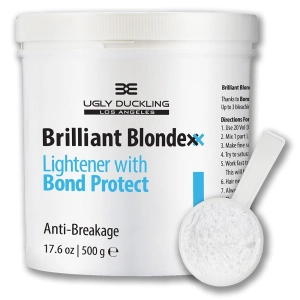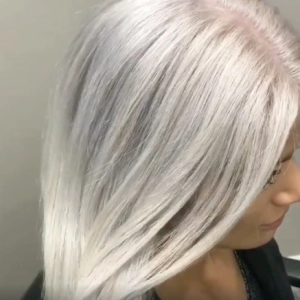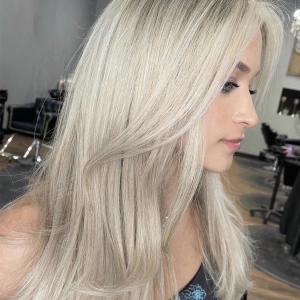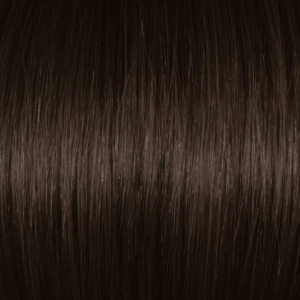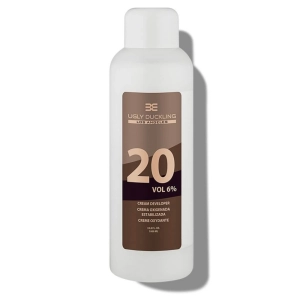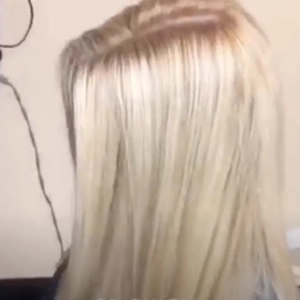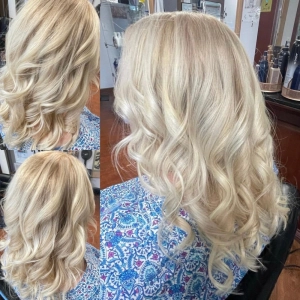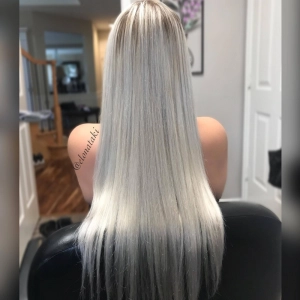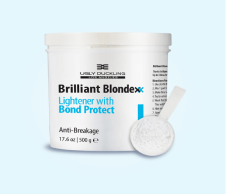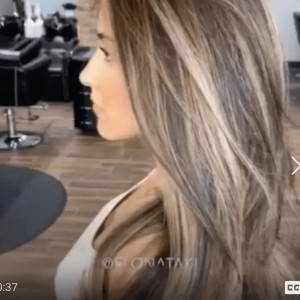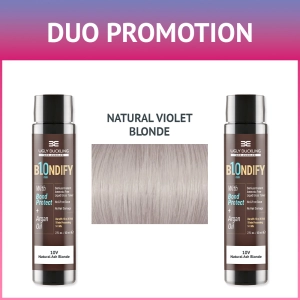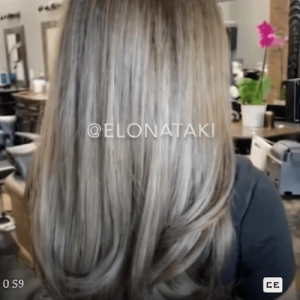Introduction
As a professional colorist, mastering the art of grey coverage is crucial to delivering exceptional results and ensuring client satisfaction.
In this comprehensive guide, we will explore techniques and tips tailored to various hair levels, providing you with the expertise needed to achieve flawless grey coverage using professional color products.
Understanding grey hair
Before diving into the techniques, it's essential to understand the nature of grey hair.
Grey hair results from a reduction in melanin production, causing hair to lose its natural color.
This reduction in melanin happens at the individual hair level, and as it happens, each individual hair goes white.
When that happens we call the hair grey, but it is in fact is a blended mixture of white hairs and the client's natural hair color.
Because new hair grows from the root, these white hairs appears at the root area first, and then extend towards the ends.
When hair goes white it can sometimes also go very coarse and resistant. This then creates new problems, which require special attention during the coloring process.
The advantage of using the right professional color products
Selecting high-quality professional color products is the foundation for successful grey coverage.
The advantage of using professional products is not only that you get superior quality formulation and pigments.
You also get a much larger palette of final color results to choose from.
All sorts of vivid fashion color results are possible, not just level on level coloring.
You can also decide to cover grey and go significantly lighter, for example.
As a result you can have perfect grey hair coverage without compromising in any way with the final color result
Step One: assess the percentage of grey hair
Making an assessment of how much grey hair your client has is the first step.
Check at the regrowth area because that is where you can see the grey hair the best.
Use the images below to help you decide how much grey hair your client has:
20% Grey hair
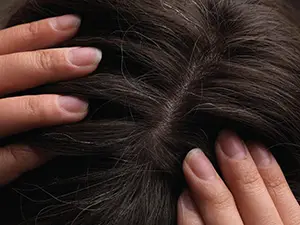
40% Grey hair

70% Grey hair
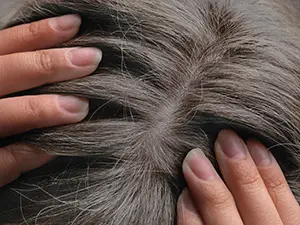
Step Two: determine your client's natural hair color level.
So now what we are trying to find out is your client's natural hair color level.
This is not the color that shae has colored her hair in the past but the level of her natural non-white, and non-colored hair color.
If your client has previously colored her hair, look at the regrowth area to help you decide.
Use this chart to help you decide:
.jpeg)
Hair color levels. Use this chart to determine your client's natural non-colored, non-white hair level
Step Three: ask your client to decide what color she wants to be
In principle, any color is achievable.
You can either use a color chart to determine what your client's target color is going to be.
You can also use the Ugly Duckling webpage.
Very often women choose a color one to two shades lighter than the client's natural color to achieve a natural look.
But women can also opt to go much lighter. And go blonde, for example.
In general, going lighter has 2 potential advantages.
First, the lighter you go, the white hair stand out less and is less noticeable.
So the easier it gets to cover grey.
Secondly, the overall result is often more natural looking and younger when you take your client's hair lighter.
Choice of developer and whether or not to bleach
Once you have done the above, you also need to determine your choice of developer and whether or not you are going to bleach.
If your target color is darker, at the same level as or within 1-2 levels of your client's natural hair color level, you should use 20 Vol developer.
If your target color is 3 levels or more greater than your client's natural hair color, you will need to use bleach first to lift the hair, then color.
Note: we do not recommend the use of 10 Vol developer unless your client is going darker and has 15% or less grey hair.
The reason is that with grey hair coverage you do need to open up the hair cuticle and color the natural melanin of the hair.
Otherwise you won't get good grey hair coverage, you won't get a good color result and the result will not be long lasting.
Adding in base to improve grey hair coverage
Now we come to a very important topic - the topic of adding in base or filler to your target color.
By adding in base you ensure you get really good grey hair coverage.
This is one of the very important things a stylist can do to get the perfect balance between great grey hair coverage and a beautiful color result.
The rule is you mix in some base color (or extra coverage base color) in with the target color that has been chosen.
This base color should be at the same level as the target color.
So if for example, the client's target color is 6A/6.1 Dark Ash Blonde.
You would need to add in some base 6N as a filler.
So how much of this base would you add?
Let's now go through that below.
If a client has around 25% grey hair, add in 25% of base.
So for example, let's say that your client has level 7 blonde hair with 25% grey hair.
Let's say that you are aiming for level 9 and your client wants to go ash blonde.
That would make her target color, or chosen color 9.1, or 9A.
But you need to add in some base. So you need to mix in some 9N in with the 9A.
In this case your proportions would be 25% 9N and 75% 9A.
If a client has around 50% grey hair, add in 50% of base.
Let's now assure that the client has 50% grey hair (or thereabouts).
In that case you would reduce the amount of her target color and increase the amount of filler or base.
So staying with the women who wishes to go 9A, we would use 50% 9A and 50% 9N.
If a client has around 100% grey hair use 100% base.
Let's say we are now with a woman whose hair is 100% grey.
In that case, although she wants to go 9A, we would need to use 9N instead.
Her 100% grey hair would need that amount of base to get good coverage.
Regular base or extra coverage base?
Hairdressers often ask us which color to use as the base.
Our recommendation is use the regular base (any color ending in N) for any color level 7 and above.
And use the extra coverage (any color ending in NN) for any color level 6 or below.
In general, the extra coverage bases are only for women with very thick, dark hair which is very resistant to grey hair coverage.
Asian hair, African hair and Hispanic hair in particular.
If you are going for level 7 and up, then the regular base will be good enough.
Some additional comments on developer choice and use
Use 20 Vol developer for most grey hair coverage situations.
20 Vol developer will give you the optimum opening of the hair cuticle and will allow you to get a good mixture of color vibrancy and coverage.
Use 30 Vol developer only if you are trying to lift the hair using High Lift color (see below) and blend away grey at the same time.
You should only do this when the natural hair is already quite light - level 7 blonde and above.
Use a 1+1 developer mix ratio. So, for example if you are using a whole tube of color, with Ugly Duckling tubes, you would be adding 3.5 oz of developer into your 3.5 oz of color.
Use a kitchen scale to weigh out your products in order to get the best results - although it is true to say that experienced stylists do it by sight also.
Once you have got your products in the mixing bowl, mix using a plastic whisk until you have a really smooth, creamy mix.
Ugly Duckling products have a lot of tolerance built in, so it is not a big deal if there is a little too much or a too little of developer.
Use gloves as you can see in the picture below.

Ugly Duckling developer and color
Application rules for grey hair coverage
For grey hair coverage, it is best to start at the regrowth area.
This is where you see the most grey hair.
Remember to saturate the hair really really well with product.
That is the key for getting great grey hair coverage and a really rich color result.
Once you have applied there, extend on to the lengths.
Apply with a brush, segmenting carefully so that every part of the hair comes into contact with the product.
Once you have applied everywhere, you should do a second application.
Make a small amount of fresh mix if necessary.
This time rub in with fingers using gloves.
By doing this you will help get better coverage and also better color vibrancy.
Leave in for 30 minutes.
You can leave in for an extra 10 minutes (that is to say, 40 minutes) in cases where the hair is very thick and resistant to grey hair coverage.
Covering grey and going blonde

As we said earlier, many women take the arrival of grey hair as an opportunity to go blonde.
And as we already said, at Ugly Duckling we do believe that this is generally a good idea.
Let's now cover the steps you need to take to do this.
First, lift the regrowth area
If your client has already gone blonde, but her dark regrowth is showing, then it is the regrowth that needs to be taken blonde first before you do anything else.
For the roots, we would suggest that you use Brilliant Blondexx with Bond Protect.
It is gentle enough to be applied on the root area, and yet it has powerful lift and will allow you to lift with only 20 Vol developer in most cases.
At the same time it contains Bond Protect, meaning that it is gentle and that it keeps the hair string and prevents hair breakage.
Also (and this is particularly important for older women whose scalp is sometime quite sensitive) when mixed with developer it produces a very white creamy mix which provokes much less scalp irritation as compared to most resgular bleaches.
 (1).jpg)
Brilliant Blondexx Bleach with Bond Protect
Make a mix of 1 part Brilliant Blondexx to 2 parts 20 Vol developer, then add to all the parts that need lifting.
If the lengths (anywhere apart from the root) also need lifting, now is the time you would need to extend your mix to this part.
Make a fresh mix to do so as necessary.
Keep checking and processing, add in fresh mix as necessary, until all the hair is a consistent level 10 blonde.
Below is a picture of what the hair should look like after bleaching.

Bleached level 10 hair at the backwash
Second, tone
Once the hair has lifted properly, rinse off with tepid water and towel dry.
Hopefully your client's hair should now be a clean blank canvas, lifted consistently to level 10.
Now you need to tone.
Which products should you tone with?
As we said before, any blonde color is possible.
So, we suggest you use any of our permanent blonding toners, some of which are given below:




GETTING GREY HAIR BLONDE - WATCH VIDEO:
Hair by Bozey Tedstone, Route 66
Adding in base when going blonde
You still need to use the rule of adding in base when when you go blonde.
How much base should you use?
With hair which is at level 10, we suggest (whatever the percentage of grey hair), that you use 50% base and 50% your chosen toner.
And which base should you use?
We suggest you opt for 10N or 9N are the best choices.
10N if the grey hair is around 30% or less.
And 9N is the grey hair is more than 30%.


LIFTING DARK ROOTS & GOING BLONDE - WATCH VIDEO :
Hair by Elona Taki.
Going Blonde To Cover Grey At the Same Time - Using High Lift Color
When the natural base is level 7 and above, and when the hair is quite fine and takes color easily, you can get away with using high lift color instead of using bleach.
Use Ugly Duckling's 100.11 with 30 Vol in that case.
It is a deep ash based high lift, and you can use it on the roots.
Then extend onto the lengths to refresh them.
Note: in this case we opted not to use base.
We judged that there was not that much grey hair and that the highlift color could blend it away easily enough.


